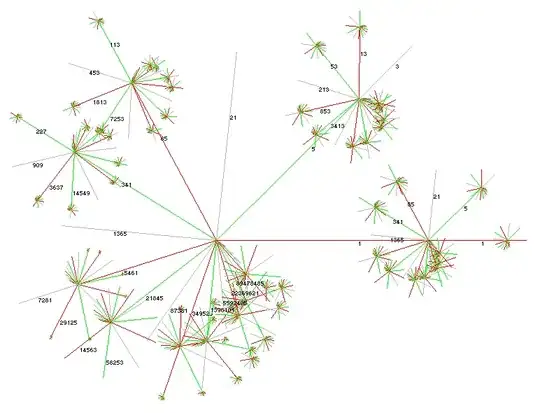I know that the set of powers of 2 and the set of 1,5,21,85,341,... are proven to be true for Collatz conjecture. Are there other sets with infinite number of numbers that are also proven to satisfy Collatz conjecture?
-
2Surely, we can construct many such families considering the iteration used in the Collatz function. – Peter Aug 22 '19 at 11:48
-
my guess is that the set $2^n-1$ also can be proven... – Aug 22 '19 at 16:10
-
https://math.stackexchange.com/questions/2716155/are-there-specific-numbers-for-which-the-collatz-conjecture-is-proven/2716668#2716668 – Collag3n Aug 22 '19 at 19:01
-
1@NaturalNumberGuy if $2^n-1$ satisfies the conjecture it follows that also $3^n-1$ does right? – PrincePolka Aug 23 '19 at 08:42
-
@PrincePolka I don't know. The binary expansion of $2^n-1$ and $3^n-1$ are very different. – Aug 23 '19 at 10:36
3 Answers
$\qquad \{ 1,5,21,85,\cdots,{1 \cdot 4^k-1 \over 3}, \cdots \}$ go to $1$,
$\qquad \{ 3,13,53,253,\cdots,{10 \cdot 4^k-1 \over 3}, \cdots \}$ go to $5$,
$\qquad \{ 113,453,\cdots,{340 \cdot 4^k-1 \over 3}, \cdots \}$ go to $85$,
$\qquad \{ 17,69, \cdots \}$ go to $13$ ...
$\qquad \qquad$ and so on: infinitely many subsets!
You might like to see some examples of various forms of trees (of course which are recursive) to see a lot more subsets of odd numbers being proved to converge by these schemes. Obviously they are infinitely many such infinite subsets. But unfortunately that does not mean, that it would have been proven that all odd positive natural numbers are in that single tree.
See mainpage and then go to subpage "about numerical and graphical trees". My favourite is that "bottle-brush" like tree at the end ... 
- 34,920
-
2it is interesting that the $k^{th}$ number of the first subset can be written as $4^0+4^1+4^2+...+4^k$ since $\frac{4^{k+1}-1}{3}$ is the equation for the partial sum of the infinite series whose $r$ is $4$. – Binh Ho Aug 23 '19 at 11:45
-
1@BinhHo - of course! It might be instructive to denote that numbers in base-4-numbersystem: '1' , '11' , '111', ... Then, that of the subset $3,13,53,...$ are '3', '31' , '331', '3331' , ... Then that of the subset $17,69,...$ are '101', '1011', '10111', ... . And so on... – Gottfried Helms Aug 23 '19 at 12:49
-
upps - correction: in my previous comment should it be '3','31','311','3111',... of course. – Gottfried Helms Aug 23 '19 at 14:54
-
interesting! Do you think that from this fact we can prove all positive odd numbers? I know that the binary number system can represent all positive integers, and maybe we can deduce the 4 number system down to binary. – Binh Ho Aug 23 '19 at 15:19
-
@BinhHo - no, that is not easier than anything else. Note that the same scheme exists for the negative numbers and there we have three independent, nonoverlapping trees. Only the visualization is much more impressive than the usual one. – Gottfried Helms Aug 23 '19 at 15:42
One example is any set containing the odd integer $(2^n-1)/3$, for $n>1$.
Indeed, applying the "$3x+1$" rule to this will yield a power of $2$ and therefore the chain ends in the trivial cycle $\{4,2,1\}$.
- 5,075
-
Not a bad start, but could you extend this example a bit to somewhat less trivial sequences , for example a sequence that uses "$3n+1$" twice ? Then, I gladly upvote the answer. In fact the sequence in this answer was already mentioned by the author. – Peter Aug 22 '19 at 12:09
-
-
@Peter Take a look on this code please , Generating OEIS Sequences A062052-A062060 – PrincePolka Aug 23 '19 at 09:01
-
"...$(2^n-1)/3$ for *even* $n \gt 1$ ..." would be more selfexplanatory... – Gottfried Helms Aug 23 '19 at 10:03
-
@Peter 'forstep(n=1,100,[1,2],for(m=0,99,print((2^(2n+(3-n%3)+2m)-(2^(3-n%3)*4^m+3))/3)))' try this on for size. – Sep 15 '19 at 20:48
One can simplify the Collatz iteration by bypassing the even operation using $g_n(x)=(2^{e(x)}x-1)/3$, where $x \not \equiv 0\pmod{3}$ is any odd natural number, $e(x)$ is any positive integer exponent for which $3$ divides $2^{e(x)}x-1$. This leads to $g_n(x)=z_n+2^{e(x)}m_r$, where $e(x)=2n$ if $x \equiv 1\pmod{3}$ or $e(x)=2n-1$ if $x \equiv 2\pmod{3}$ for $n \in \mathbb{N}=\{1,2,3,\ldots\}$, $z_n$ is any element of $Z=\{1,5,21,85,\ldots\}$, and $m_r$ is the multiple of any admissible $x\pmod{3}$, i.e. $x=3m_r+r$ for $r=1,2$. With this, one finds an infinite set $\{g_n(x)\}_{n\in\mathbb{N}}$ satisfying the Collatz conjecture and repeatedly iterating $g_n$ leads to convergent odd Collatz sequences. See further details here.
- 1